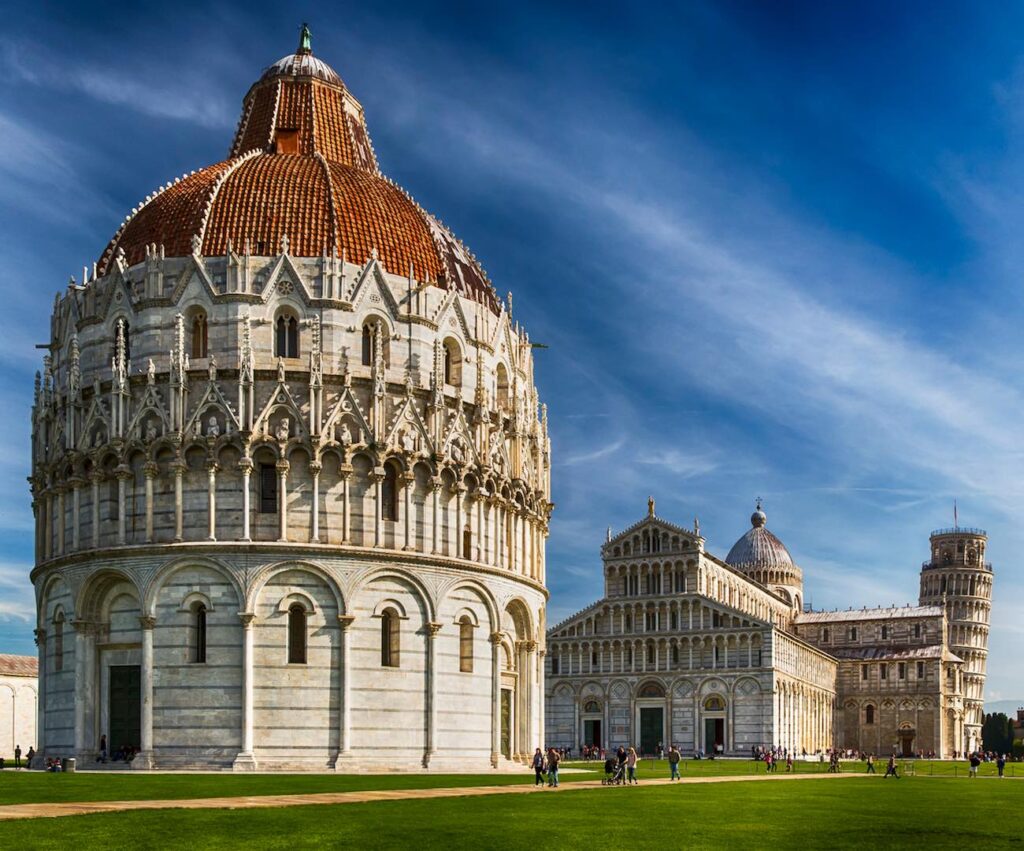The Piazza dei Miracoli (Square of Miracles), officially Piazza del Duomo (Cathedral Square), is the beating heart of Pisa and one of the world’s most famous monumental squares. Declared a UNESCO World Heritage Site, it gathers, on a single, evocative green lawn, the masterpieces that bear witness to the peak of the Maritime Republic of Pisa between the 11th and 13th centuries: the Cathedral of Santa Maria Assunta (with the iconic Leaning Tower attached), the Baptistery, and the Monumental Cemetery (Camposanto Monumentale).
The Cathedral of Santa Maria Assunta
Pisa’s Cathedral is the temple of pure white marble, constructed starting from 1064, an emblem of the Pisan Romanesque style. The project was conceived by the architect Buscheto, with work concluded by Rainaldo in the middle of the following century.
In addition to the majestic exterior, enriched with architectural elements in polychrome marble and inlays that evoke classical, Byzantine, and Islamic art, the interior housed works of inestimable value. Among these, the Door of San Ranieri stands out, a bronze masterpiece by the master Bonanno Pisano, dating back to around 1180 (today replaced by a copy, the original is located at the Museo dell’Opera del Duomo).
The door, conceived as a “Poor Man’s Bible,” is divided into 24 panels that narrate, from bottom to top, sacred scenes from the New Testament: from the Annunciation to the Ascension of Christ and the Death of the Virgin, concluding with the Glory of Christ and Mary. Bonanno reworks the Byzantine tradition with profound sculptural originality, laying the foundation for a new scenic language in medieval bronze sculpture.
The Baptistery: Art and Architecture
The Baptistery of Pisa, dedicated to Saint John, is the largest baptismal structure in Italy, an imposing building that combines the lower Romanesque style with the upper Gothic decoration, which was begun by Nicola Pisano and continued by his son Giovanni Pisano.
Nicola Pisano, considered one of the fathers of Italian figurative language, started the sculptural cycle that decorates the exterior of the Baptistery (as evidenced by an inscription from 1278), the original sculptures of which can be admired at the Museo dell’Opera del Duomo. Upon his death, Giovanni Pisano took over the direction, creating the Gothic loggia. The Pisano workshop produced statues such as the famous Ballerina (Dancer), which conveys a dynamism unprecedented for the 13th century, and the two splendid Teste (Heads) attributed to Nicola.
The architectural and decorative complex of the Piazza del Duomo, built at the peak of Pisan power, also welcomed and integrated artifacts from beyond the Mediterranean, testifying to the Republic’s commercial and cultural ties, such as the famous bronze Griffin of Islamic craftsmanship (perhaps war booty) and the statue of the Cithara-playing David of Provençal production.
The Camposanto
The Monumental Cemetery of Pisa (or Old Camposanto) is the last work in the Square, a walled monumental cemetery said to have been built on soil brought from the Holy Land.
It is not just a burial place, but a true open-air museum. Originally intended to house the Roman sarcophagi and funerary monuments removed from the Cathedral’s exterior walls, it became the resting place for illustrious figures. Its walls were frescoed by masters such as Buonamico Buffalmacco and Benozzo Gozzoli, although the frescoes were severely damaged during the Second World War and have been the subject of a long restoration.
Among the sculptural works intended for the Camposanto was the monumental Tomb of Henry VII (Arrigo VII), created by Tino di Camaino between 1313 and 1315. However, the sculptural group was dismantled over time, with some parts now preserved in the Museum of Sinopie and the Museum of the Opera del Duomo, such as the statue of the enthroned emperor.
In Piazza dei Miracoli, one perceives the greatness of a city that, thanks to its wealth and contacts with the East, was able to create a unique monumental complex, where architecture and sculpture celebrate faith, power, and art in a continuous dialogue between the ancient and the medieval.

